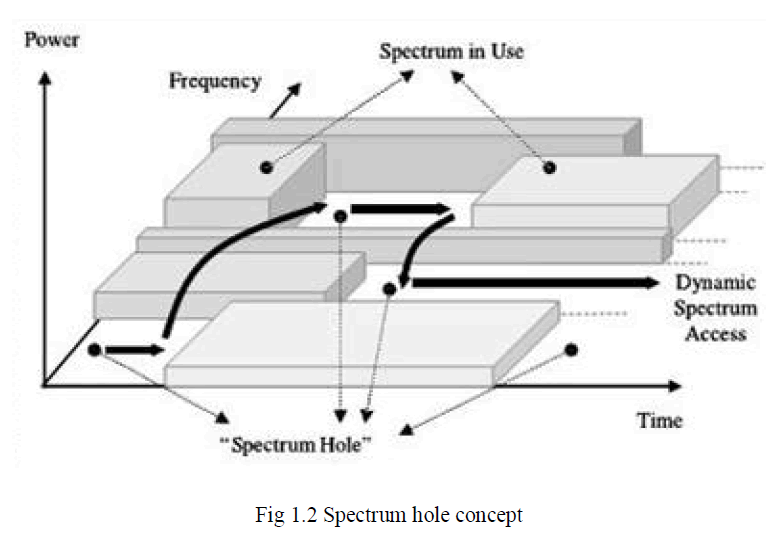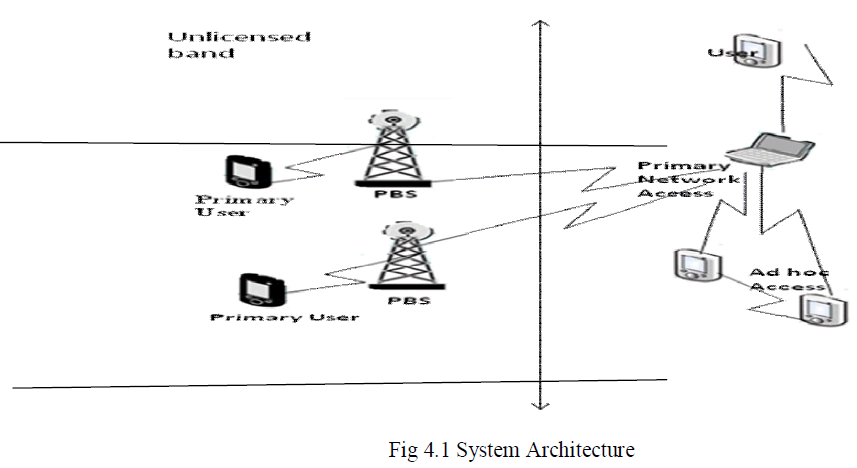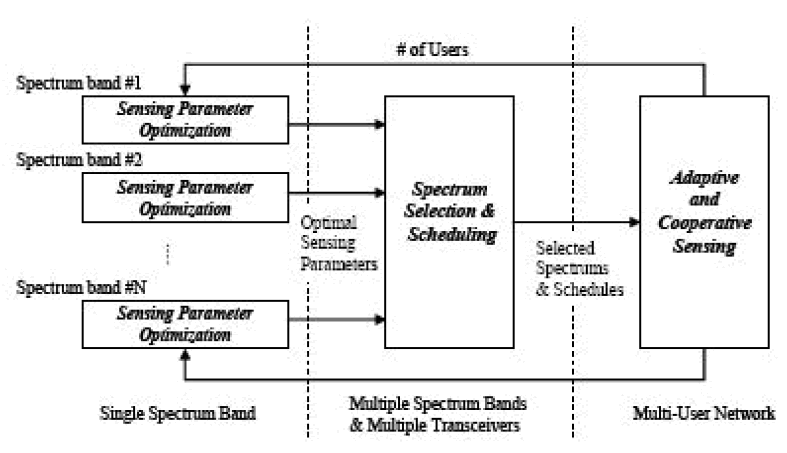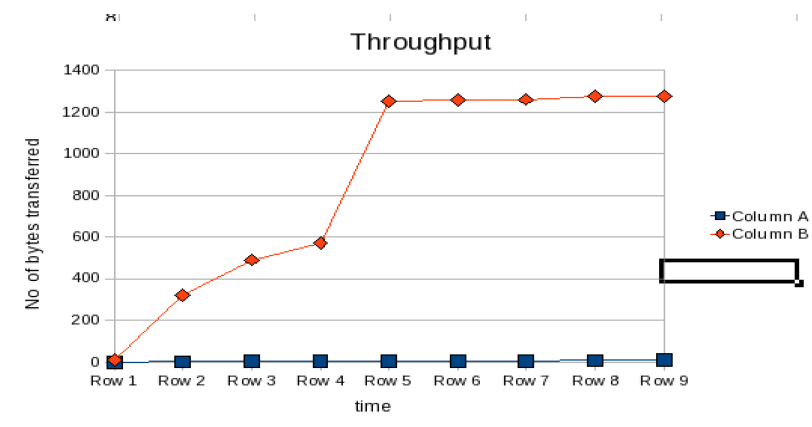ISSN ONLINE(2320-9801) PRINT (2320-9798)
ISSN ONLINE(2320-9801) PRINT (2320-9798)
| AR.Arunachalam Asst.Professor, Dept of CSE, Bharath University, Chennai, Tamilnadu, India |
| Related article at Pubmed, Scholar Google |
Visit for more related articles at International Journal of Innovative Research in Computer and Communication Engineering
Wireless network represents an efficient technology as is allows exploiting the unused radio resources as it allows exploiting the unused radio resources. It allows secondary users to opportunistically access spectrum licensed by primary users, while protecting PU activity. Spectrum sensing plays an important role in Wireless networks communication. Spectrum sensing is the key enabling technology for Wireless networks. The main objective of spectrum sensing is to provide more spectrum access opportunities to Wireless networks users without interfering with the operations of the licensed network. Hence, recent research has been focused on the interference avoidance problem.
Keywords |
| Wireless networks, Spectrum sensing, Spectrum sharing. |
INTRODUCTION |
| Spectrum scarcity has become the bottleneck for the evolution of modern wireless communication systems, which requires extra frequency resources in addition to the already allocated for the current wireless communication systems. Obtaining extra frequency resources through reallocation of current spectrum would be impractical. Therefore, one is left with the only option of efficiently reutilizing the current spectrum resources already allocated to other systems. Cognitive devices are allowed to occupy the spectrum that has been left vacant by licensed users. Therefore, every telecommunication system will be divided into two networks: a primary network called Primary Users (PUs), who owns the spectrum license and has full rights on it. A secondary network called secondary Users (SUs), who operate in license free bandwidth and or otherwise called unlicensed users. The Secondary user is allowed to use the primary networks bandwidth in case of PU absence or underutilized. |
| Licensed spectrum is a spectrum band that has rules pre-defined for both the hardware and deployment methods of the radio in such a manner that interference is mitigated by the technical rules defined for the bands rather than it being restricted for use by only one entity through a spectrum licensing approach. Unlicensed spectrum does not infringe upon the rules for the equipment (which in practical terms is all pre-certified by the manufacturer) or its use can put up a license free network at any time for either private or public purposes including commercial high speed internet service. |
| In a typical wireless network scenario, users of a given frequency band are classified into primary users and secondary users. Primary users are licensed users of that frequency band. Secondary users are unlicensed users that opportunistically access the spectrum when no primary users are operating on that frequency band. Wireless networks form when secondary users utilize“holes” in licensed spectrum for communications. These spectrum holes are temporally unused sections of licensed spectrum that are free of primary users or partially occupied by low-power interferers. The holes are commonly referred to as white or gray spaces. Figure1.2 shows a scenario of primary and secondary users utilizing a frequency band. |
 |
| The functional components are: |
| 1. Spectrum sensing - responsible for detecting unused spectrum. In order to avoid interference the radio scans the spectrum for free channels. The most efficient way is to detect the primary users of the spectrum. |
| 2. Spectrum management - responsible for capturing the best spectrum available for the required QoS of communication. First analysis is made on the spectrum for interference, path loss. |
| 3. Spectrum mobility - responsible for maintaining seamless communication during spectrum transition by using the channel information exchanges between the BSs and CPEs. |
| 4. Spectrum sharing - responsible for providing fair spectrum scheduling method for sharing the available open spectrum. |
II. PREVIOUS RESEARCH |
| Chen Sun, Gabriel Porto Villardi, Zhou Lan, Ha Nguyen Tran, Hiroshi Harada[1] proposed, the Optimizing Coexistence Performance of Secondary User Networks under Primary User Constraints for Dynamic Spectrum Access. Distribution of the interference to the PU receiver caused by SU transmitters weighted by the time slot fraction assigned to each SU network with QOs.The impact of Coexistence among secondary user (SU) networks as well as coexistence between primary user(PU) and SU networks is stated. The former addresses the sharing of a common spectrum opportunity among SU networks in order to achieve an efficient spectrum usage, whereas the latter addresses the interference from SUs to PUs. For the quantitative evaluation of coexistence, they proposed a new parameter named quality of coexistence(QoC). |
| Mansi Subhedar and Gajanan Birajdar[3] proposed, different Spectrum Sensing Techniques in Cognitive Radio Networks .Different Approaches of spectrum sensing and their complexities are discussed. ED is always accompanied by a number of disadvantages i) sensing time taken to achieve a given probability of detection may be high. ii) Detection performance is subject to the uncertainty of noise power. iii) ED cannot be used to distinguish primary signals from the CR user signals. Matched Filter technique is considered as the effective, but Matched filter detection requires a prior knowledge of every primary signal. If the information is not accurate, MF performs poorly. |
| Also the most significant disadvantage of MF is that a CR would need a dedicated receiver for every type of primary user. |
| Hong Xu, Baochun Li[4] proposed, flexible channel cooperation among SUs and Pus that cover all dimensions of resource allocation for SUs. It allows SUs to freely optimize its use of resources, including channels and time slots leased by Pus. In this model the time slot is equally divided into two slots. The first slot is used by PU to transmit to SU and the second slot is used by the SU to transmit to the primary base station and to its own access point. This model increases the spectral efficiency, which in turn translated into more cooperation opportunities. |
III. HYPOTHESIS |
| For studying the optimized channel performance, we test the following functionality with the multiple secondary users. |
| 1. Spectrum sensing |
| 2.Spectrum sharing |
| 3. Spectrum mobility |
IV. RESEARCH METHOD |
| The system describes the primary functions of the: spectrum sensing, spectrum decision and spectrum sharing. Spectrum sensing determines which portion of the spectrum is available and detects the presence of licensed users, when a user operates in a licensed band. Spectrum decision selects the best available channel for communication. Spectrum sharing is to coordinate fair spectrum access to the channel with other users. When a licensed user is detected, the SU should vacate the channel for seamless communication. |
4.1 Proposed system Architecture |
 |
4.2 Spectrum sensing |
| Spectrum sensing is the ability to measure, sense and be aware of the parameters related to the radio channel characteristics, availability of spectrum interference and noise, radio’s operating environment, user requirements and applications, available networks and nodes, local policies and other operating restrictions. It is done across Frequency, Time, Geographical Space, Code and Phase. The Spectrum Sensing types are classified into cooperative detection, Transmitter detection and Interference based detection. Matched filter, Energy detection comes under Transmitter detection. |
| It is necessary for the wireless network system to continuously sense the spectrum occupancy. Typically a Wireless networks system will utilize the spectrum on a non-interference basis to the primary user. Accordingly it is necessary for the Wireless networks system to continuously sense the spectrum in case the primary user returns. |
 |
| The detailed scenario for the optimal sensing framework is as follows. According to the radio characteristics, basestations initially determine the optimal sensing parameters of each spectrum band through the sensing parameter optimization. When users join the networks, they select the best spectrum bands for sensing and configure sensing schedules according to the number of transceivers and the optimized sensing parameters by using spectrum selection and scheduling methods. Then, users begin to monitor spectrum bands continuously with the optimized sensing schedule and report sensing results to the base-station. Using these sensing results, the base-station determines the spectrum availability. If the base-station detects any changes which affect the sensing performance, sensing parameters need to be re-optimized and announced to its users through the adaptive and cooperative sensing. |
4.3 Spectrum allocation decision |
| Once the available spectrums are identified, it is essential that the users select the most appropriate band according to their QoS requirements. It is important to characterize the spectrum band in terms of both radio environment and the statistical behaviors. of the PUs. In order to design a decision algorithm that incorporates dynamic spectrum characteristics, we need to obtain a priori information regarding the PU activity. Spectrum decision involves jointly undertaking spectrum selection and route information. Since there may be multiple users trying to access the spectrum, their transmissions should be coordinated to prevent collisions in overlapping portions of the spectrum. Spectrum sharing provides the capability to share the spectrum resource opportunistically with multiple users. |
| If a PU is detected in the specific portion of the spectrum in use, users should vacate the spectrum immediately and continue their communications in another vacant portion of the spectrum. For this, either a new spectrum must be chosen or the affected links may be circumvented entirely. Thus, spectrum mobility necessitates a spectrum handoff scheme to detect the link failure and to switch the current transmission to a new route or a new spectrum band with minimum quality degradation. This requires collaborating with spectrum sensing, neighbor discovery in a link layer, and routing protocols. Furthermore, this functionality needs a connection management scheme to sustain the performance of upper layer protocols by mitigating the influence of spectrum switching. |
V. SIMULATION RESULTS |
| In this section of paper we present analysis the results of the proposed system. The performance analysis can be done by plotting the graph with time and no of bytes transferred. |
 |
VI. SUMMARY AND CONCLUDING REMARKS |
| Smart radios are able to identify spectrum (i.e. radio frequencies) that is not being used, and to quickly tune to that frequency to transmit and/or receive signals. They also have the ability to instantly find other spectrum if interference is detected on the frequencies being used. The ultimate objective of the Wireless networks is to obtain the best available spectrum through cognitive capability and reconfigurability. In order to exploit the cooperative gain, the system proposed adaptive and cooperative sensing functionality mainly running on the centralized network entities such as a base-station.We propose further study in using different sensing techniques to the system and estimate the performance analysis to optimize the spectrum allocation. |
References |
|